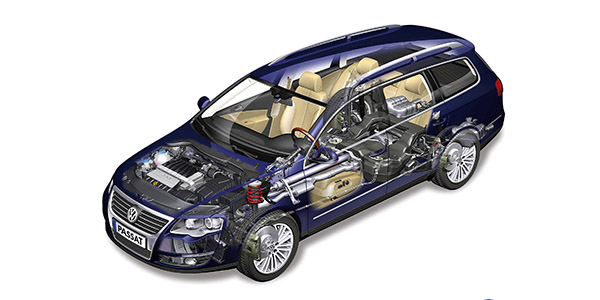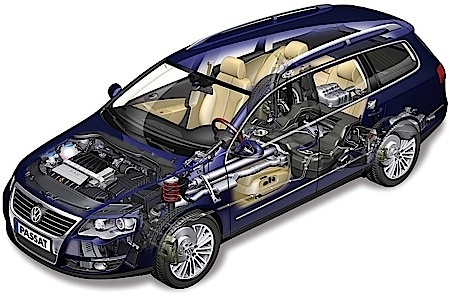Alignment Specs: 2006-2010 Volkswagen Passat And 2009-2012 CC (B6 Platform)
The VW B6 Passat for 2006 was an entirely new design. It was followed by the coupe CC in 2009. The complicated four-link front suspension from the B5 platform with four ball joints was replaced with a cast-aluminum lower control arm and a MacPherson strut. In the rear, the Passat received an independent suspension with a trailing link design.

Alignment Specs: 2006-10 Volkswagen Passat
The VW Passat for 2006 was completely new. The four-link front suspension with four ball joints was replaced with a cast-iron lower control arm and a McPherson strut. In the rear, the Passat received an independent suspension with a trailing link design. Also, the design of the AWD model was much more simplified. But, when

Servicing 1996 To 2005 Volkswagen And Audi Vehicles
In this article, I’ll take a look at the designs and repair of the suspension, brake and exhaust systems of Volkswagens and Audis from 1996 to 2005. I won’t be able to cover everything in this article, just some of the highlights of the various models. VW and Audi produced cars in two- or four-wheel-drive configurations, in several body styles and with a number of powertrains. These cars seem to be everywhere here in the Pacific Northwest. There is a model that fits just about every need and with the available Quattro and 4Motion drivetrains they make excellent ski and mountain vehicles.
Volkswagen Tech Tip: Solving Suspension Creaking Noise
Select Volkswagen vehicles may exhibit a creaking noise originating in the front suspension while entering steep driveways or over large bumps. The source of this noise could be the forward inner control arm bushing. To confirm if this is the issue, raise the vehicle and remove the wheel on the suspected side.
P2181 Code: Volkswagen Check Engine Light Is On
Trouble Code P2181 (18613) is for cooling system performance. It generally means that the vehicle has a defective or leaking thermostat. If the vehicle does not warm up quickly enough to go into closed loop operation within the time programmed into the engine control module, it will set this code. This is generally cured by replacing the thermostat.
Volkswagen Tech Tip: Check Engine Light Is On, Trouble Code P2181
Volkswagen owners may complain that the check engine light is on. Potential causes of a trouble code P2181 include the connector, defective coolant temperature sensor (CTS) wiring or defective thermostat.
Volkswagen Tech Tip: Check Engine Light Is On With Fault Code P0420
If you encounter a check engine light on with a fault code P0420 stored in the fault memory, this may be the result of a defective catalytic converter.
Tech Tip: Volkswagen’s MIL On with DTC P129F/P310B Set
Due to fuel intrusion into the low pressure side fuel pressure sensor (G410), a false signal may be sent to the ECM resulting in a reading that is out of tolerance. A false signal may result in illumination of the malfunction indicator lamp (MIL) and DTC P129F or P310B being stored in fault memory. There is now an improved fuel pressure sensor (G410) to aid against fuel intrusion.
Tech Tip: Volkswagen MIL is On, with DTCs P0087/P1093 or P2293
The MIL is on, with DTC P0087 (Fuel Rail/System Pressure Too Low), P1093 (Fuel Trim 2, Bank 1 Malfunction) or P2293 (Fuel Pressure Regulator 2 Performance) stored in the ECM’s fault memory. This could be caused by excessive wear of the intake camshaft lobe that drives the high-pressure fuel pump. The wear limits maximum pump piston lift, causing fuel rail pressure fluctuations. The wear on the camshaft lobe can also lead to wear on the base of the high-pressure fuel pump cam follower.
Tech Tip: Volkswagen Check Engine Light is on with Fault Code P0420
If you find that the Check Engine Light (MIL) is on with fault code P0420 (16804) stored in the fault memory, the condition may be caused by a defective catalytic converter(s). If any other fault codes are present besides catalyst (CAT) faults, the other codes must be addressed and corrected before proper/complete CAT testing can be performed.
